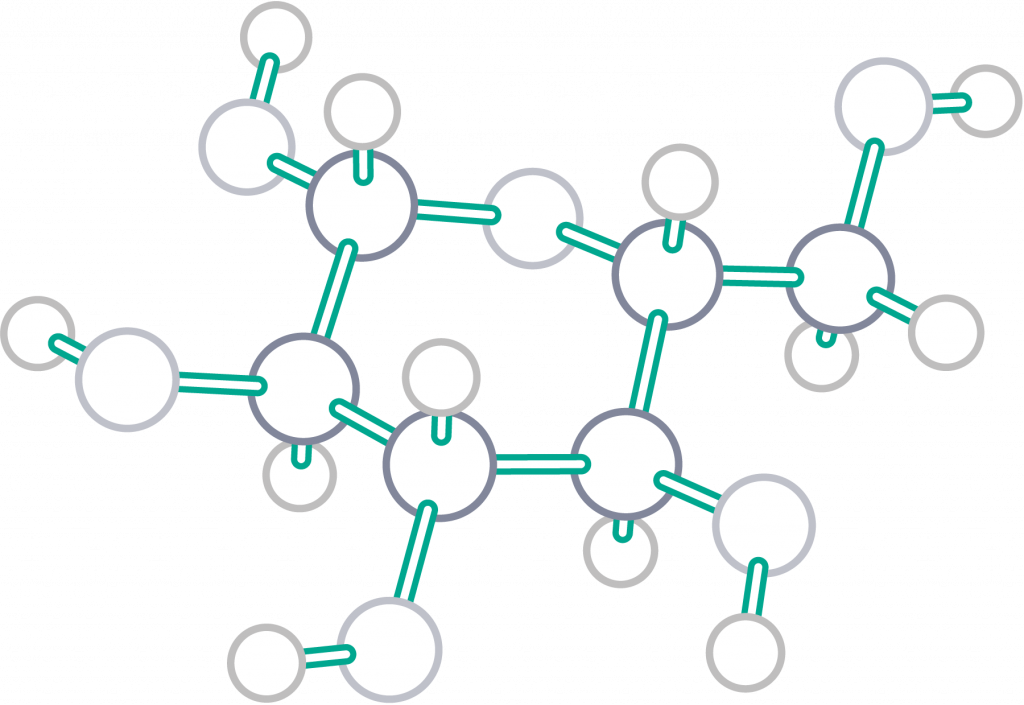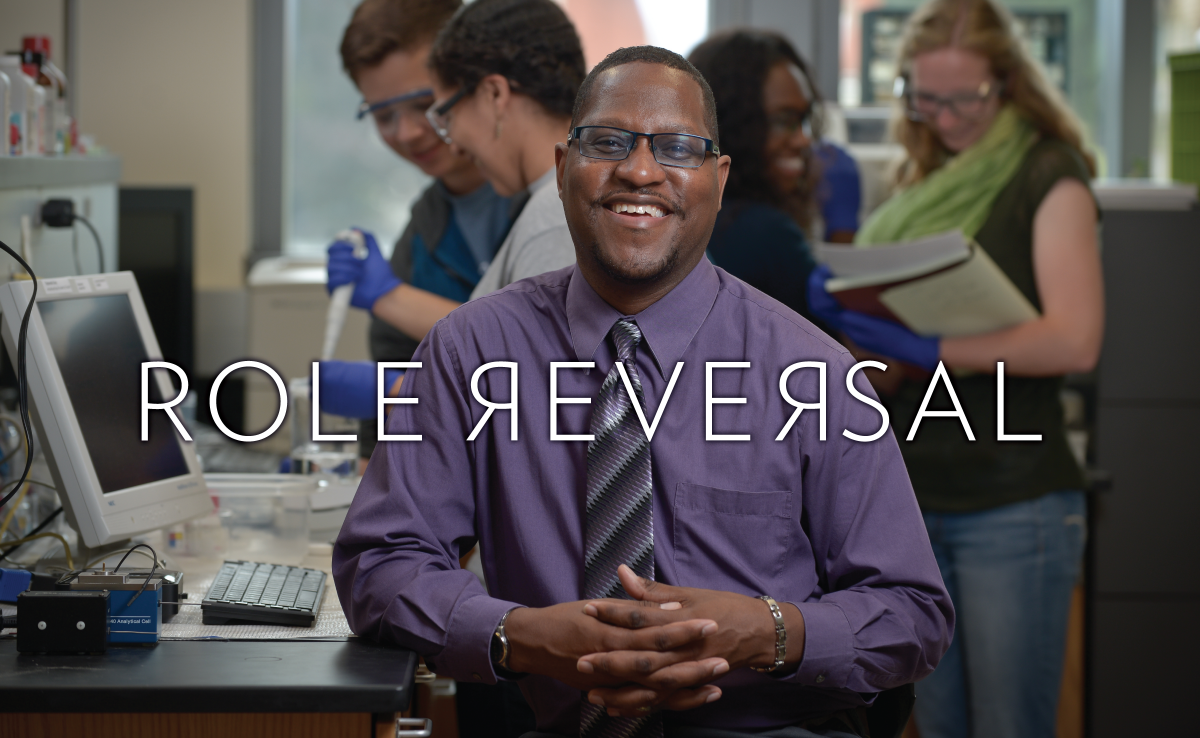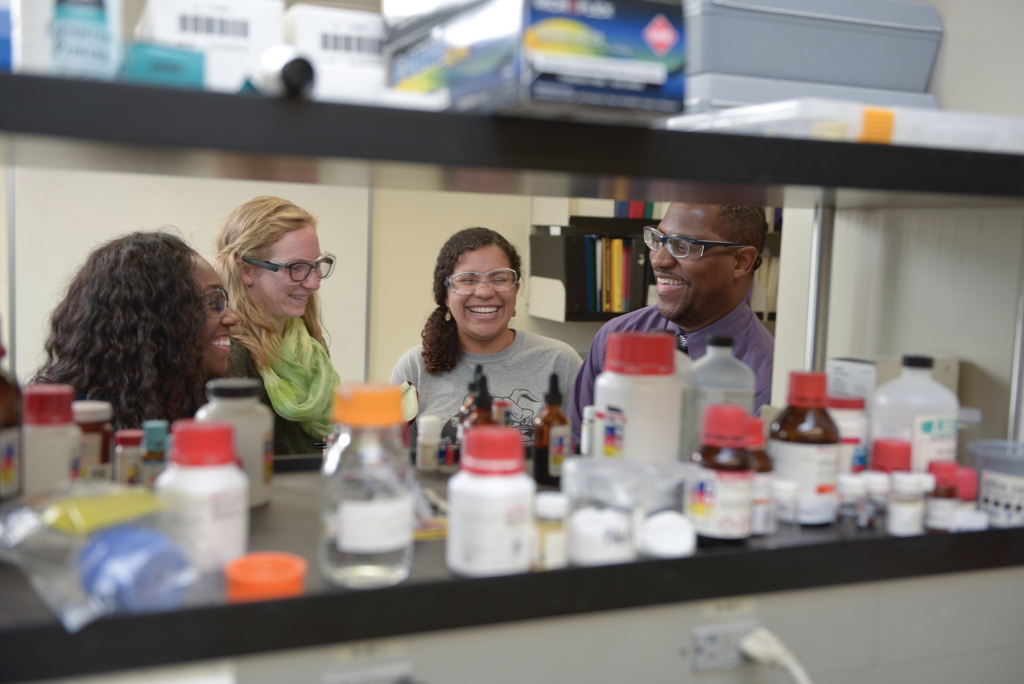Role Reversal
In Dr. Kenneth Brown’s analytical chemistry laboratory, details are amenable obsessions. Precise measurements, exact reaction times, specific compound properties, meticulous journal notes — it all requires a special law and order of the chemical kind. While the terms bantered about in Schaap Science Center lab 2116A would make any layperson’s head spin with their particular minutiae (try these: redox mediation, organo-metallic complexes, monomers for oxidative electropolymerization feasibility for 3,4 ethylenedioxythiophene (EDOT), Fe(II) and Ru(II)-tris(5-amino-1,10 phenanthroline) and metal(II)-tetraaminophthalocyanine), Brown’s rules of research have big-picture implications, too. They are not unlike the canons he learned in his mother’s kitchen and go something like this (paraphrased a bit):
- Always put things back where you found them.
- Always clean up your mess.
- Always take good notes if you change the recipe.
- Always be careful.
- Always work hard.
- Always love on chemistry and each other.
That last rule — to love your work and the people in it — is more implied than written, and it is the rest of this detailed story.
Go back to 2004–05, and Brown is five years into his Hope career, having come to the college right after receiving his doctorate from Oklahoma State University. He excelled through six years of grad school on his strong intellect and the GI bill. A former sergeant in the U.S. Army Reserve, Brown is a man given to affability but not pretension; orderliness but not compulsion; discipline but not impatience. Each attribute makes him an attractive magnet to Hope chemistry students who appreciate his creativity and enthusiasm. Get Brown going about those redox mediators and his voice takes on a gleeful lilt as his hands move about complementing his every vocal inflection, exposing his penchant for using two more body parts to help his mouth do the talking.
Jill Pinter Berryman, Travis Ruch and Kathy Ewing Davis — all 2005 Hope graduates and all now with Ph.D.s in chemistry — were three such students who gravitated to Brown’s way of thinking and working (and talking) back then. For two summers and two academic years, the threesome conducted research in Brown’s lab in the field of electrochemistry. They all had been students in his class on “Analytical Chemistry,” too. After spending so much time together, “we were a pretty close-knit group,” confides Davis who is now an associate professor of chemistry at Manchester University.
So close that when the students noticed something was gravely amiss with Brown’s health in the spring of 2005, the three undergraduates had the considerate audacity to step in and ask their professor why. It would be an extravagant display of courageous care for a faculty member by students,
a role reversal of the magnanimous and unusual kind.
The autumn before, Brown was turning his research focus toward the use of organo-metallic compounds in bio-sensing devices such as glucose detection meters most often used by those with diabetes. As God and providence would have it, at that same time Brown began to notice changes in his body as well. His vision was blurring, he was constantly thirsty, he had high urine output, and he was losing weight though not even trying. He kept diving deeper into diabetes research literature. Was he being psychosomatic, or did he really need medical attention? “I was fortunate that at that time I was reading those research papers on diabetes,” admits Brown, who is single. “As I’m reading them, I’m thinking, ‘I have to get myself to a doctor.’”
When he did, his first blood sugar reading was over 500, more than three times above normal glucose range. He was immediately put on insulin and other medications but it took several weeks to regulate his glucose, and the struggle left him drained. Still, he worked. As severe as his diagnosis was, he took no time off from Hope. Brown researched, taught, advised and mentored. And he told no one of his newly detected disease.
But Berryman, Davis and Ruch caught the details of change in their professor, by now a friend as much as a mentor. Brown’s sweaters were becoming baggy and his pants were looser. His teaching style had changed, too. It was erratic; sometimes he’d be full of his usual energy and sometimes it took all that he had to get through the day. Everything about Brown — his mannerisms, energy level and personality — was altered. Like his clothes, none of his normal characteristics seemed to fit. He was not himself, and his students were determined to find out why.
“So one day I was walking down the hall and they cornered me — all three of them — right outside my office door,” Brown recalls. “They said, ‘Okay, Dr. Brown, we want to know what’s going on. We notice something is not right with you.’”
When faced with the order, the former military man had no option but to comply. Brown had been ambushed and now was surrounded, and the three students were not going to let him get away without an answer. The chemistry professor who was thinking about researching compounds to benefit the diabetic community admitted to his own recent diagnosis.

Now that the mystery had been addressed, the students offered assistance. “They said, ‘If you need anything from us, we’re here for you,’” says Brown. And they meant it, for the day after their confrontation the three came back bearing a gift for their weary prof. In its unwrapping, Brown uncovered a cookbook for individuals with diabetes.
“Then they said to me, ‘Dr. Brown, look through this cookbook and pick out a couple recipes. We are going to come to your home, take over your kitchen, and cook for you. You must do this. You have no choice,’” recalls Brown. “So I chose some recipes and they cooked for me twice that semester. . . For them to take that interest in me told me that they appreciated me as their mentor, but more than that they cared about me as a person. It spoke volumes to me that they would go to that extent.”
While one ultimatum delivered from students to a faculty member is rare, two are certainly unheard of. But Berryman, Davis and Ruch had no doubt then that repaying kindness with kindness was as important a lesson learned in Brown’s research lab as discovering the next new characterization of chemically modified electrodes (see Rule #6 again).
“To fully understand that situation, you have to know a couple of things about Ken,” says Ruch, now a pharma consultant for BioTech in Westfield, New Jersey. “First, he’s incredibly kind and generous with his time. Second, he has high expectations of his students and mentees. So when he was diagnosed with diabetes, we wanted to offer him support and kindness too and let him know that we expected him to attack the problem with the same vigor that a physical chemistry student attacks molecular orbital theory.”
Berryman, now the manager for user relations at the National Superconducting Cyclotron Laboratory at Michigan State University, concurs. She has witnessed the cutthroat nature of high-level, competitive research at larger institutions and knows there is a difference back at Hope. “I think of Dr. Brown’s soft-spoken nature, his patience in the lab with his students, his infinite kindness, and know that, yes, there were indeed other ways to be an academic,” she says.
For as often as Hope is called a caring, Christian community, it is such encounters that turn anecdotal evidence into fact. And though this story may be 12 years old, a testament to its currency is the effects Brown has on his students and colleagues still to this day. “Dr. Brown is extremely well loved amongst students and deeply respected by his colleagues,” confirms senior Isiaha Kyles who has conducted research in Dr. Brown’s lab for the past two years. “I’m at UC-Irvine this summer where I’ve happened to meet a couple of chemistry grads from Hope and they all ask me about Dr. Brown and how he’s doing. He truly does touch the lives of each of his students.”
“My research would not be made possible without the support of my research students,” Brown concludes. “And the biggest influences on my life during my time at Hope have been my mom (Helen Brown) and best friend (Becky Pearson). They all have inspired me.”
When the students noticed something was gravely amiss with Brown’s health in the spring of 2005, the three undergraduates had the considerate audacity to step in and ask their professor why.
So you see, not much has changed about Brown since the Great Role Reversal of 2005, well, except the management of his diabetes. He’s doing fine now, stablizing his weight mostly through diet and the execution of more than 100 pushups daily, dropping to pump out at least 10 every hour even in his office. He and his research students continue to find ways to make glucose test strips more efficient (multi-use and less blood sample needed) and cheaper (paper instead of plastic). And Brown is still warm, wise and humble. From his small chemic details to his big-hearted kindnesses, Rule #6 long lives.
Photos by Jon Lundstrom


